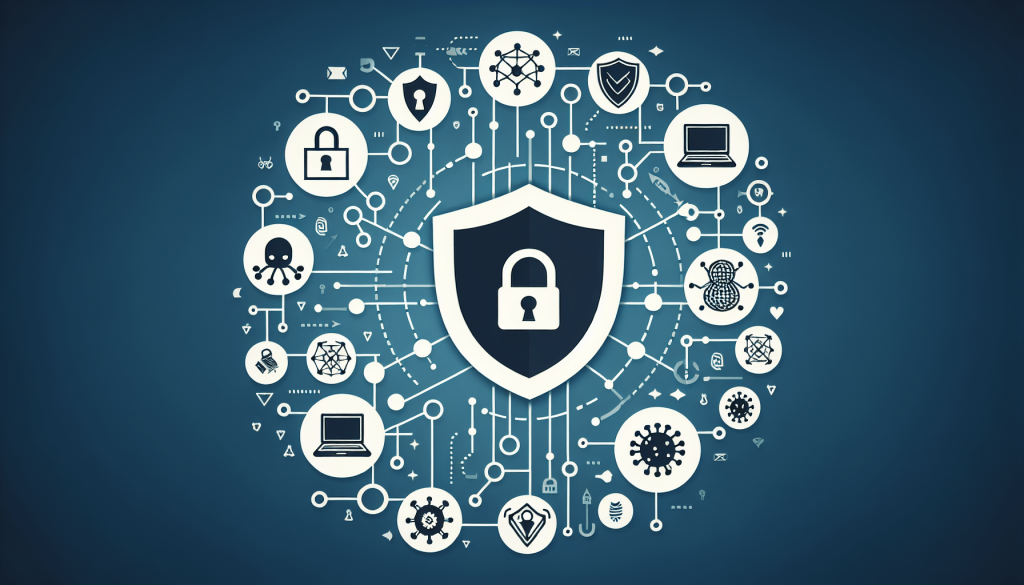Are you new to the world of network security and feeling a bit overwhelmed by all the tech jargon and complex concepts? Fear not, because “The Beginner’s Guide to Network Security: A Step-by-Step Approach” is here to help! This ultimate guide has been carefully crafted to provide beginners like you with a clear and comprehensive understanding of network security, all explained in a friendly and easy-to-follow manner. From understanding the basics of network architectures to implementing effective security measures, this guide will take you on a step-by-step journey towards becoming a proficient network security guru. So, let’s embark on this exciting adventure together and unlock the secrets of network security!
Understanding Network Security
The importance of network security
Network security is of paramount importance in today’s digital world. With the increasing dependence on technology and the interconnectedness of devices, protecting your network from cyber threats has become essential. By implementing robust network security measures, you can safeguard your sensitive information, prevent unauthorized access, and ensure the uninterrupted operation of your network.
Key concepts of network security
Network security is a vast field that encompasses various key concepts. Understanding these concepts is crucial in fortifying your network against potential threats. Some of the fundamental concepts include:
- Confidentiality: Ensuring that only authorized individuals have access to sensitive information.
- Integrity: Verifying that data remains unaltered during transmission and storage.
- Availability: Ensuring that resources and services are accessible to authorized individuals when needed.
- Authentication: Verifying the identity of users and devices to establish trust.
- Non-repudiation: Providing proof of communication or transaction to prevent denial of involvement.
- Access control: Implementing measures to limit unauthorized access to network resources.
By grasping these key concepts, you can better understand the principles and strategies behind network security and make informed decisions to protect your network effectively.
Assessing Network Vulnerabilities
Identifying potential threats
Before implementing network security measures, it’s important to identify potential threats that your network may face. These threats can include:
- Malware: Harmful software designed to damage or gain unauthorized access to a computer or network system.
- Phishing: Deceptive tactics used to trick users into revealing sensitive information like passwords or credit card details.
- Network attacks: Various types of attacks, such as Denial of Service (DoS) attacks or Man-in-the-Middle attacks, which can disrupt network operations or intercept data.
- Unauthorized access: Intrusions by hackers or individuals attempting to gain unauthorized access to network resources.
Understanding these potential threats allows you to proactively implement measures to mitigate the risks and protect your network from vulnerabilities.
Performing vulnerability assessments
To assess the vulnerabilities in your network, it is essential to conduct regular vulnerability assessments. These assessments involve identifying weak points in the network infrastructure, which attackers could exploit. By performing vulnerability scanning and penetration testing, you can uncover potential weaknesses and take appropriate corrective actions. Regular assessments should be conducted to address any new vulnerabilities that may emerge due to software updates, new hardware installations, or changes within the network environment.
Understanding common vulnerabilities
Common vulnerabilities can make your network more susceptible to attacks. Some of the most prevalent vulnerabilities in network security include:
- Weak or unchanged default passwords: Failing to change default passwords on network devices is a common oversight that can be exploited by attackers.
- Inadequate software updates: Delaying or ignoring software updates leaves known vulnerabilities unpatched, making it easier for attackers to exploit them.
- Misconfigured firewalls: Incorrectly configured firewalls can provide a false sense of security, allowing unauthorized access to your network.
- Lack of encryption: Failing to encrypt sensitive data puts it at risk of interception and unauthorized access.
- Weak wireless network security: Insufficient security measures on wireless networks may allow attackers to gain unauthorized access to your network resources.
Understanding these vulnerabilities is crucial in designing and implementing effective security measures to protect your network.

Securing Network Devices
Implementing strong passwords
One of the most basic and essential steps in network security is implementing strong and unique passwords for all network devices. A strong password should be long, include a combination of uppercase and lowercase letters, numbers, and special characters. It is crucial to avoid using easily guessable information such as birthdays or common words. Additionally, password managers can be used to create and store complex passwords securely.
Configuring firewalls
Firewalls act as the first line of defense against unauthorized access to your network. Configuring your firewall correctly is vital to ensure that only authorized traffic is allowed while blocking suspicious or malicious activity. You should carefully define firewall rules, allowing only necessary ports and protocols for communication. Regular monitoring and updating of firewall configurations are essential to maintain a strong security posture.
Updating firmware and software
Keeping your network devices’ firmware and software up to date is crucial in maintaining their security. Manufacturers periodically release updates that address security vulnerabilities and improve performance. Failing to update your devices leaves them vulnerable to exploitation. It is advisable to regularly check for updates and apply them promptly, ensuring your network devices are equipped with the latest security patches.
Encrypting Network Communications
Understanding encryption protocols
Encryption plays a vital role in securing network communications by encoding data to make it unintelligible to unauthorized individuals. Some common encryption protocols used in network security include:
- Secure Sockets Layer (SSL)/Transport Layer Security (TLS): Protocols that establish secure connections between web servers and clients, ensuring confidentiality and integrity of data transmitted over the network.
- Internet Protocol Security (IPSec): A protocol suite used to secure IP communications, providing confidentiality, integrity, and authentication.
- Virtual Private Network (VPN): A network technology that enables secure remote access by encrypting data traffic between the user and the network.
Understanding these encryption protocols allows you to choose the right security measures for your network, based on your specific requirements.
Implementing secure protocols
To ensure secure network communications, it is crucial to implement secure protocols consistently. This includes using SSL/TLS for website communications, enabling IPSec for secure network connections, and utilizing VPNs for remote access. By implementing these protocols, you can protect the confidentiality and integrity of your data, making it extremely difficult for attackers to intercept or manipulate your network communications.
Securing wireless networks
Wireless networks present unique security challenges due to their broadcast nature. To secure your wireless network, you should:
- Change default usernames and passwords on wireless access points.
- Enable network encryption using Wi-Fi Protected Access 2 (WPA2) or higher protocols.
- Disable broadcasting the Service Set Identifier (SSID) to make the network less visible to outsiders.
- Implement strong pre-shared keys (PSKs) for wireless network authentication.
- Regularly update firmware on wireless access points to patch any vulnerabilities.
By implementing these measures, you can significantly enhance the security of your wireless network and prevent unauthorized access.

Implementing Access Controls
User authentication methods
User authentication is a critical aspect of network security, ensuring that only authorized individuals can access network resources. Some commonly used authentication methods include:
- Password-based authentication: Users provide a unique username and password combination to verify their identity.
- Two-factor authentication (2FA): Users provide an additional piece of information, such as a temporary code generated by a smartphone app, along with their password.
- Biometric authentication: Users authenticate using unique physical traits, such as fingerprints or facial recognition.
By selecting and implementing appropriate user authentication methods, you can establish strong access controls and prevent unauthorized access to your network.
Assigning user privileges
Assigning user privileges ensures that each user has access only to the resources necessary for their role. By implementing the principle of least privilege, you restrict users’ ability to make unauthorized changes or access sensitive information. Assigning privileges should be based on job requirements and regularly reviewed to ensure they align with the users’ responsibilities.
Implementing access control lists
Access Control Lists (ACLs) allow network administrators to define and enforce access rules for specific resources or network segments. By configuring ACLs, you can control which users or groups have privileges to access certain data, services, or devices. Regularly reviewing and updating ACLs ensures that access rights remain up to date, minimizing the risk of unauthorized access.
By implementing robust access controls, you can effectively manage user access, reduce the risk of unauthorized activity, and protect your network from potential threats.
Protecting Against Malware
Identifying types of malware
Malware refers to malicious software designed to harm your network or gain unauthorized access. Understanding the different types of malware can help you implement effective protection measures. Some common types of malware include:
- Viruses: Malware that replicates itself and spreads to other files or systems.
- Worms: Self-replicating malware that replicates across networks without user interaction.
- Trojan horses: Malware disguised as legitimate software to trick users into installing it. It often opens a backdoor for attackers or steals sensitive information.
- Ransomware: Malware that encrypts files or locks up a user’s computer until a ransom is paid.
- Spyware: Malware that secretly collects user information without their consent, often used for identity theft or unauthorized surveillance.
Identifying these types of malware allows you to employ targeted prevention and mitigation strategies specific to each threat.
Installing and updating antivirus software
Installing and regularly updating antivirus software is crucial in protecting your network from malware. Antivirus software scans files and detects patterns or signatures associated with known malware. It can also analyze suspicious behavior to identify potential threats. Configuring automatic updates ensures that your antivirus software has the latest virus definitions, maximizing its effectiveness in detecting and preventing malware infections.
Educating users about malware prevention
Educating users about the risks of malware and providing guidelines for safe online practices is vital in preventing infections. Some key points to emphasize in user training include:
- Regularly updating software and operating systems to patch vulnerabilities.
- Avoiding clicking on suspicious links or opening attachments from unknown sources.
- Being cautious when downloading files or applications from the internet.
- Using strong passwords and enabling two-factor authentication for additional security.
- Being vigilant about phishing threats and never sharing personal information through unsecured channels.
Regular training sessions and reminders can empower users to be proactive in preventing malware infections and maintaining network security.
Monitoring and Detecting Intrusions
Implementing intrusion detection systems
Intrusion Detection Systems (IDS) play a crucial role in monitoring network traffic and detecting potential intrusions or suspicious activity. They can either be network-based or host-based. Network-based IDS analyze network traffic in real-time, while host-based IDS monitor individual devices for signs of compromise. By implementing IDS, you can receive alerts and take immediate action to prevent or mitigate potential security incidents.
Monitoring network logs
Monitoring network logs provides valuable insights into network activity and helps detect any anomalies or potential security breaches. Network logs can capture information such as login attempts, resource access, and network communication patterns. By regularly reviewing and analyzing network logs, you can identify any unusual patterns or signs of unauthorized access, allowing you to take appropriate action to prevent further compromise.
Investigating and responding to security incidents
In the event of a security incident or breach, it is crucial to have an organized and effective response plan. This plan should include steps to isolate affected systems, gather evidence, mitigate any further damage, and restore systems to a secure state. Timely and appropriate response minimizes the impact of a security incident, helps identify the root cause, and informs future prevention strategies.
By monitoring network activity and promptly responding to security incidents, you can proactively protect your network from potential intrusions and mitigate the impact of any breaches.
Securing Remote Access
Setting up secure remote access methods
Secure remote access allows authorized individuals to connect to your network from outside locations. To establish secure remote access, you should:
- Enable Virtual Private Network (VPN) connections, which encrypt data traffic between the user and the network, ensuring secure communication.
- Utilize Secure Shell (SSH) for secure command-line remote access to network devices.
- Implement Remote Desktop Protocol (RDP) with appropriate security measures like strong passwords and two-factor authentication.
By implementing secure remote access methods, you can enable seamless collaboration while ensuring the confidentiality and integrity of your network communications.
Using virtual private networks (VPNs)
VPNs provide encrypted and secure connections for remote users, allowing them to access network resources as if they were on-site. VPNs establish a secure “tunnel” between the user’s device and the network, encrypting all data transmitted over the internet. By utilizing VPNs, you can protect sensitive information from interception and unauthorized access, even when accessing the network from untrusted networks.
Implementing multi-factor authentication
Multi-factor authentication (MFA) adds an extra layer of security to remote access by requiring users to provide additional authentication factors beyond just a password. This could include a temporary code sent to their mobile device or biometric authentication. By implementing MFA, you mitigate the risk of unauthorized access even if passwords are compromised, ensuring only authorized individuals can connect to your network remotely.
By securing remote access methods, you can enable safe remote connectivity and ensure that network resources remain protected, regardless of the user’s location.
Backing Up and Restoring Data
Importance of data backup
Data backup is crucial for network security because it enables the recovery of data in the event of data loss, system failure, or a security breach. Regularly backing up important data ensures its availability and reduces the impact of potential downtime. Backups should be stored securely off-site or in the cloud to protect against physical damage or data loss due to disasters or theft.
Choosing backup solutions
Choosing the right backup solutions depends on factors such as the volume of data, recovery time objectives, and budget constraints. Some common backup solutions include:
- Tape backups: Storing data on magnetic tape cartridges, which can be accessed sequentially.
- Disk backups: Storing data on hard drives or solid-state drives for faster and more efficient backup and recovery.
- Cloud backups: Storing data on remote servers accessible over the internet, providing scalability, easy accessibility, and off-site storage.
It is advisable to opt for a backup strategy that combines multiple solutions to ensure redundancy and improve the likelihood of successful data recovery.
Testing and restoring data backups
Regularly testing data backups is essential to ensure their integrity and effectiveness in restoring data. Testing backups allows you to identify any issues or corruption early and make necessary adjustments to the backup process. Additionally, periodically restoring data from backups helps confirm that you can successfully recover critical data if the need arises.
By implementing a robust backup strategy and regularly testing backups, you can minimize the impact of data loss or security breaches and ensure the continuity of your network operations.
Educating Employees on Network Security
Creating security policies and guidelines
Creating comprehensive security policies and guidelines helps establish a framework for network security and sets expectations for employees. These policies should cover areas such as password management, acceptable use of network resources, incident reporting procedures, and remote access protocols. By clearly communicating expectations and providing guidelines, employees are better equipped to follow security best practices and contribute to a security-focused culture.
Providing training and awareness programs
Training and awareness programs play a vital role in educating employees about network security risks and best practices. These programs should cover topics such as phishing, malware prevention, password security, and safe browsing habits. Regular training sessions, workshops, and simulations can help reinforce knowledge, improve awareness of social engineering tactics, and empower employees to actively contribute to network security.
Promoting a security-focused culture
Promoting a security-focused culture is essential to ingraining good security practices within your organization. This involves creating an environment where network security is valued and prioritized by all employees. Regular communication, recognition of security-conscious behavior, and fostering a supportive environment for reporting potential security incidents can help cultivate a culture that actively contributes to network security.
By educating employees and promoting a security-focused culture, you can significantly enhance your network security posture and reduce the risk of security breaches caused by human error.
In conclusion, understanding network security is crucial in mitigating the risks and threats faced by modern networks. By implementing strong security measures, regularly assessing vulnerabilities, and educating employees, you can safeguard your network, protect sensitive information, and ensure the smooth operation of your digital infrastructure. Proactive network security measures are essential in an ever-evolving digital landscape, and by following the best practices outlined in this guide, you can take significant steps towards securing your network effectively.
